How to Spot and Fix Common Stove Electrical Problems
Updated: 13 Jul 2025
252
Ever had your stove suddenly stop working right when dinner’s almost ready? It’s frustrating, and sometimes even dangerous. Electric stoves, while reliable, can develop hidden issues that most homeowners ignore—until it’s too late.
Common stove electrical problems aren’t always easy to spot. From a burner that won’t heat to a stove that keeps tripping the breaker, these issues could be signs of something serious.
“Electrical faults may start small, but in the kitchen, even a spark can lead to disaster.” — Certified Appliance Technician
In this post, you’ll learn how to identify early warning signs, diagnose basic electrical issues, and know when it’s time to call a pro.
How to Know If Your Stove Has Electrical Issues
Some stove electrical problems are obvious. Others are silent until they become dangerous. The key is spotting the early warning signs before things get worse.
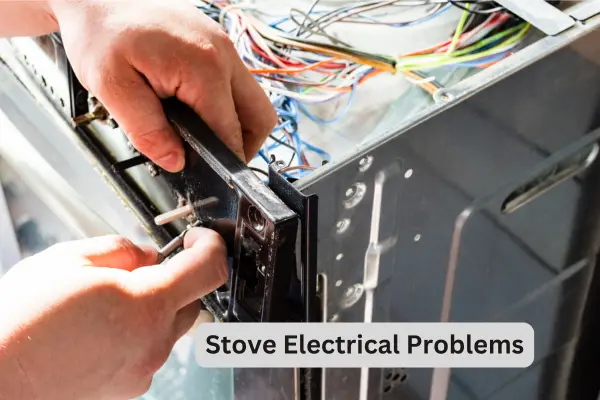
Signs Your Stove Has Electrical Problems:
Here’s a simple checklist:
- Stove is not turning on but the power is on
- Display or control panel not responding
- The heating element is not working properly
- Stove keeps tripping the breaker
- Flickering lights or buzzing noise
- Unusual burning smell or heat from the outlet
- Electric shocks when touching the stove
- Unusual behavior after a power outage
If you notice any of these, stop using the stove and inspect it. These are common signs of stove electrical problems, and ignoring them can lead to electrical fires or permanent damage.
5 Common Electrical Problems Found in Stoves (With Fixes)
Let’s break down the most common stove electrical problems homeowners face.
1. Stove Not Turning On, But Power Is On
If your electric stove won’t turn on but other kitchen devices work fine, the problem may be inside the stove:
- Burnt-out fuse
- Damaged stove power cord
- Loose wire inside the control panel
Solution:
- Test another appliance in the same outlet to rule out a bad socket
- Unplug the stove and check the cord for burns or damage
- Still not working? Call a licensed technician
2. Stove Keeps Tripping the Breaker
This means something inside is overloading your circuit:
- Shorted heating element
- Faulty internal wiring
- Overloaded outlet
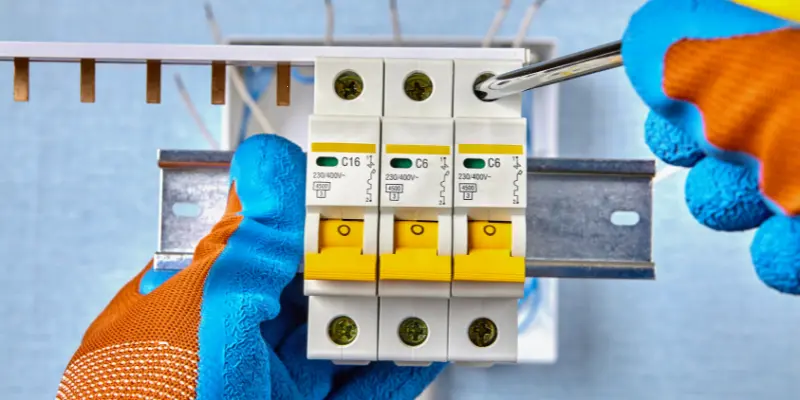
Quick Fixes:
- If breaker keeps tripping even when stove is alone, call an electrician
- Move the stove to a dedicated circuit
- Don’t plug anything else (like a microwave) into the same outlet
Learn how to stay safe with our post: What Size Breaker Do You Need for an Electric Stove?
3. Electric Stove Burner Not Heating Properly
A weak or dead burner may mean:
- Heating element failure
- Loose connection under the coil
- Control board not sending power
Fixes:
- Swap the burner with one that works.
- Check the coil connections (if removable)
- If none of that works, the element or board needs replacement
4. Stove Control Panel Not Working
Digital stoves rely on a main control board. If it freezes or buttons stop working:
- Power surge may have fried the board
- Internal wire could be burnt
Quick Fixes:
- Unplug the stove, wait 5 minutes, and plug it back in
- Still frozen? The control board may be damaged
- Avoid DIY here— it’s best to let a pro handle panel repairs
5. Why Does My Stove Spark?
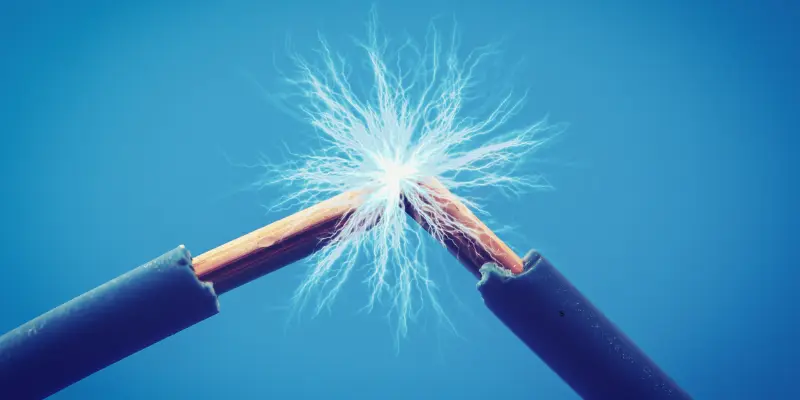
Sparking is a red flag. It may be:
- Exposed wire
- Bad connection
- Moisture inside the control unit
Solution:
- Turn off the power at the breaker
- Call a licensed electrician to check wall outlets and wiring
- Don’t use the stove again until it is cleared as safe
Less Common But Serious Electrical Problems in Stoves
Not all stove electrical problems are obvious. Some are rare, but dangerous. Here are the hidden but serious issues:
1. Arcing Behind the Stove
Electrical arcing happens when current jumps between damaged or loose wires. It creates visible sparks or a burning smell. This is a major fire hazard. Signs include:
- Buzzing or crackling sounds
- Scorch marks on wall outlets
- Melting or discoloration of outlet covers
If you notice this, unplug the stove immediately. Contact a licensed electrician.
2. Melted or Blackened Outlet
A burnt outlet behind the stove is often caused by:
- Overloaded circuits
- Loose plug
- Poor quality wiring
Do not reuse that outlet until it’s inspected. Replace it using UL-certified electrical parts.
3. Stove Shocks When Touched
If you feel a tingling sensation when you touch your stove, it could be:
- Improper grounding
- Live wires touching the metal frame
- Damaged terminal block
4. Overheating Wires Inside the Wall
Hidden wires can overheat due to:
- Old wiring
- Loose connections
- Wrong breaker size
If you smell burning plastic but see nothing on the stove, check the wall socket.
| Safety Tip |
|---|
If you spot any of the above signs, stop using the stove immediately. Don’t try to open or fix hidden electrical parts. Your safety comes first. |
Understanding the Causes: Why These Problems Happen
Here are the most common triggers behind stove electrical failures:
1. Loose or Faulty Wiring
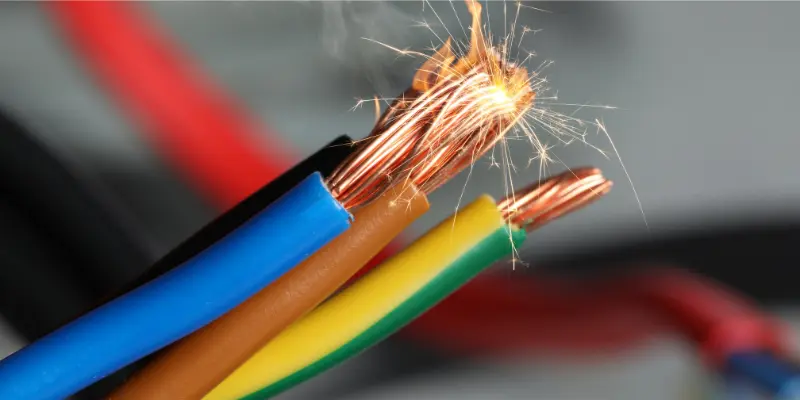
Wires can get loose with heat cycles or be damaged by rodents. This causes:
- Burnt smells
- Flickering control panels
- Tripping breakers
2. Worn-Out Stove Heating Element
Over time, heating elements burn out or lose conductivity. You may notice:
- One burner doesn’t heat up
- Slow heating
- Uneven temperatures
3. Circuit Overload or Blown Fuse
If your stove shares a circuit with other heavy appliances, it can overload. This leads to:
- Breaker tripping often
- Random shutdowns
- Blown internal fuses
4. Damaged Stove Power Cord or Wall Outlet
If the cord is frayed or the plug feels loose, it can cause:
- Arcing
- Power loss
- Melted outlet
Moisture or Grease Inside Electrical Components
Kitchens are messy. Water and oil can get into control panels or under the knobs.
This leads to:
- Short circuits
- Spark hazards
- Unresponsive buttons
Quick Troubleshooting Guide
| Problem | Possible Cause |
|---|---|
| Stove not turning on | Blown fuse, faulty wiring, tripped breaker |
| Stove is not turning on | Failed heating element or bad connection |
| Stove trips breaker every time | Circuit overload or short circuit |
| Display flickers or freezes | Power surge or bad control board |
| Shocking when touched | Improper grounding or faulty wiring |
| Burner heats slowly | Worn-out element or loose terminal |
Repair vs Replacement: What’s the Cost?
| Problem | DIY Cost | Pro Repair Cost | Replacement Cost |
|---|---|---|---|
| Broken knob | $5–$10 | $50–$80 | – |
| Heating element | $25–$50 | $100–$150 | – |
| Control board | – | $200–$400 | $600–$1,200 |
| Burnt wiring | – | $150–$300 | – |
| Full stove replacement | – | – | $800–$2,000+ |
How to Test Electrical Components (Safely)
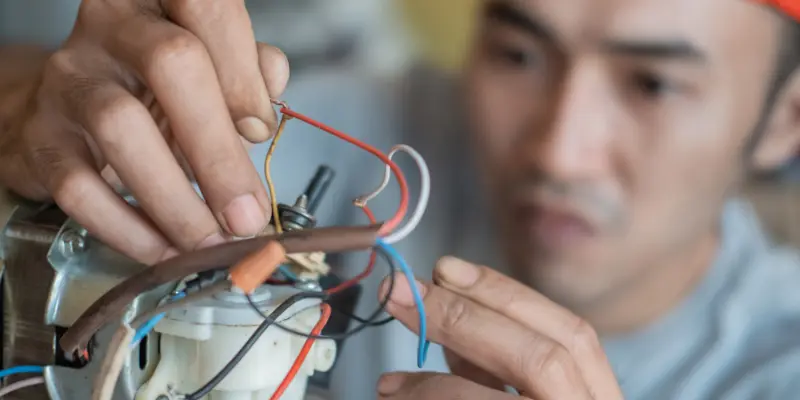
If your stove stops working or behaves strangely, you can run a few safe tests before calling a professional. This helps you identify if the problem is minor or serious. But safety comes first.
Here’s a simple way to begin testing:
Tools You’ll Need
- Multimeter
- Voltage detector pen
- Insulated gloves
- Screwdriver
1. Continuity Test on the Heating Element
Your stove heating element may stop working due to a breakage inside the coil.
How to test:
- Unplug the stove completely.
- Remove the suspect element.
- Set your multimeter to continuity mode.
- Touch both probes to the ends of the element.
Note: If it beeps or shows continuity, the element works. If not, you’ll need a replacement.
2. Testing Fuses and Terminal Blocks
Some stoves have internal fuses that blow after a surge. Others have terminal blocks where power cords connect.
Steps:
- Open the back panel carefully.
- Locate the fuse (usually cylindrical or blade-type).
- Use a multimeter to test continuity.
- If no reading, the fuse is bad.
Note: If the terminal block is discolored, melted, or loose, do not use the stove until it’s repaired.
Can You Fix It Yourself? Or Should You Call an Expert?
Many homeowners ask: Can I fix stove wiring myself?
The short answer: Sometimes yes, but often no. Let’s break it down.
DIY-Friendly Fixes
You can safely try these on your own if you follow instructions carefully:
- Resetting the circuit breaker
- Replacing stove knobs
- Swapping out a heating element
- Tightening a loose plug
When to Call a Professional
Stop immediately and call an expert if you notice:
- Burnt wires or melted insulation
- Control panel not responding
- Repeated tripping of the breaker
- Sparking, smoke, or burning smell
- Electric shocks when touching the stove
These are signs of internal electrical faults that need licensed help.
Preventing Future Stove Electrical Problems
Good habits prevent most electrical stove faults. Here’s how to prevent common issues:
1. Inspect the Power Cord Monthly
- Look for cracks, bends, and burns
- Check for a loose plug fit
- Never run the cord under a rug or mat
2. Clean Grease and Moisture Often
- Wipe burners and knobs after cooking
- Don’t let spills run into the control panel
3. Don’t Overload the Circuit
- Plug the stove into its own outlet
- Don’t share the circuit with a microwave, toaster, or dishwasher
4. Use Surge Protection
- Install a surge protector or dedicated breaker
- Avoid cooking right after a blackout
5. Annual Professional Check
Hire a certified technician once a year to inspect:
- Internal wiring
- Terminal block
- Heating elements
- Outlet load
FAQs
Can a faulty stove increase electricity bills?
Yes. Damaged wiring or inefficient elements draw more power and cause spikes in energy usage.
How long do stove heating elements usually last?
On average, 5–10 years, depending on usage and maintenance.
Can power surges permanently damage my stove?
Yes. Especially the control board and digital display. Use a surge protector always.
Why does my stove trip the breaker only when all burners are on?
Your circuit might be too weak to handle full power load. Or, a heating element could be shorting internally.
Final Thoughts
Common stove electrical problems are more dangerous than they seem. A stove that won’t turn on, a heating element that stops working, or a breaker that keeps tripping—these are not just small issues.
Many of these problems start small and grow with time. That’s why it’s important to spot the signs early, test the parts safely, and take quick action.
The best way to avoid costly repairs is prevention. Keep your stove clean, inspect the wiring, and don’t overload circuits.
Stay alert. Stay safe. And always treat electrical problems seriously.
References
https://www.ul.com/services/iec-60335-1-standard-safety-household-and-similar-electrical-appliances
https://ehs.cornell.edu/campus-health-safety/occupational-safety/electrical-safety
Please Write Your Comments